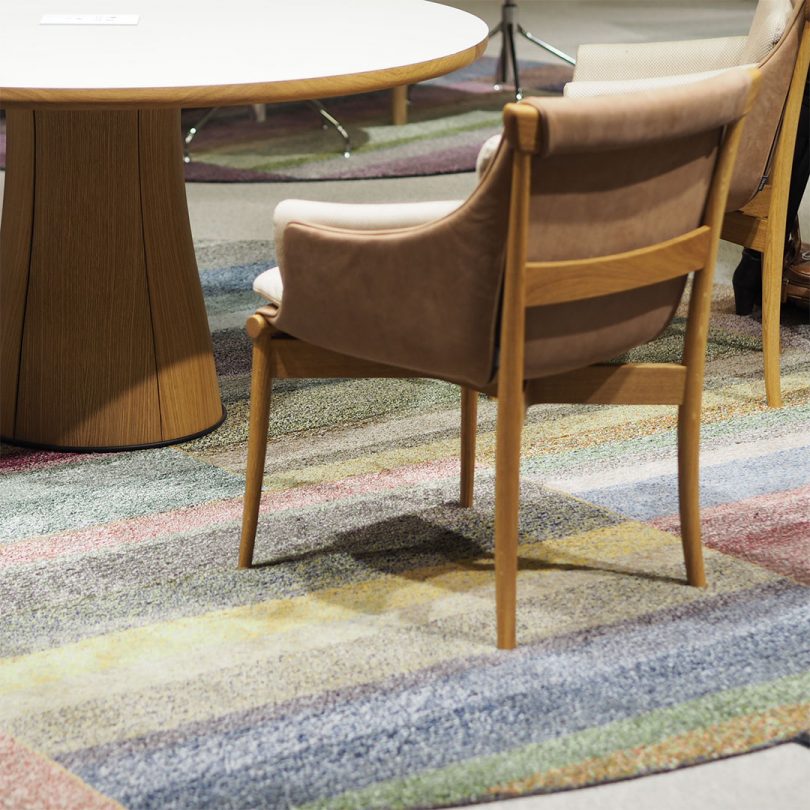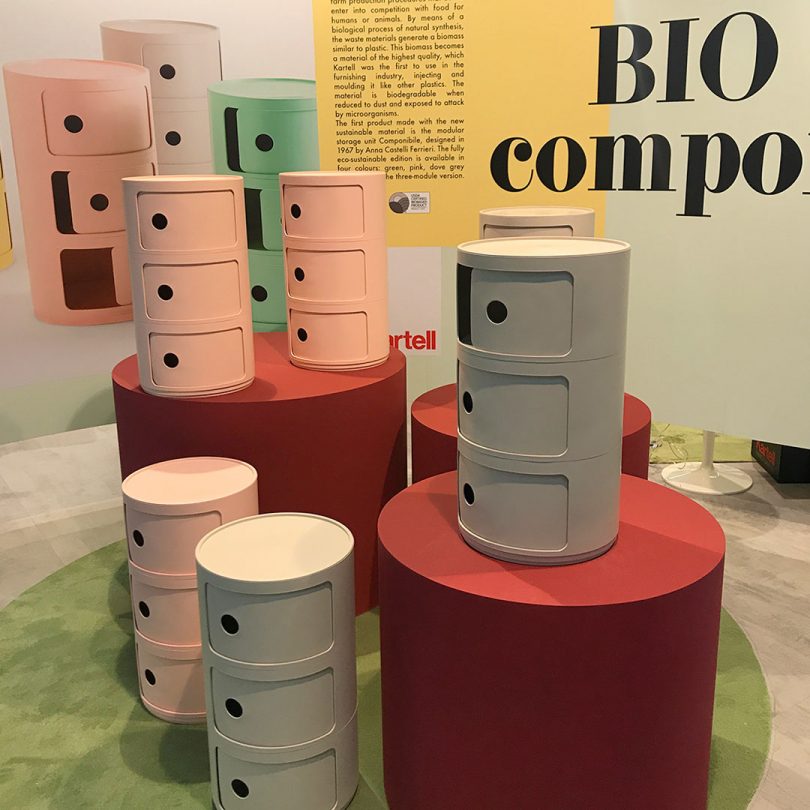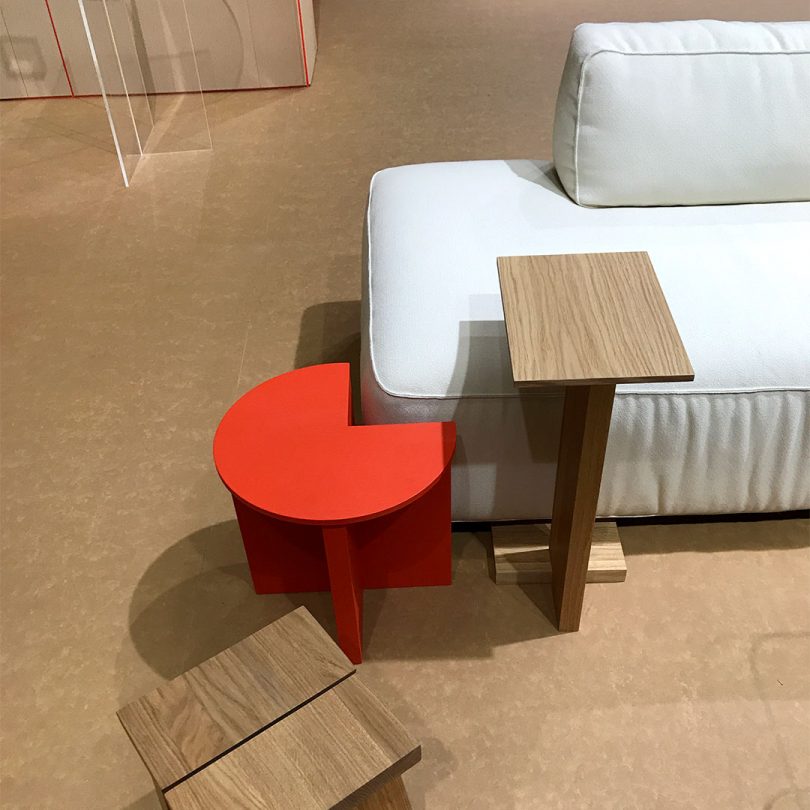As the Stockholm Furniture Fair marks its 70th anniversary, we round up our top picks from the global showcase of Scandinavian design that has evolved from a local exhibition founded in 1951 into one of the most progressive events on the design calendar.
While other fairs’ environmental efforts so far this year might have felt tokenistic at best, sustainability was the ‘red thread’ that ran through the Stockholm Furniture Fair. Kasthall launched its second rug based on circular production techniques using its own waste as a raw material. Designed in-house by Ellinor Eliasson, Flourish solves the problem of mismatched left-over yarn, by weaving it all together into a patchwork-style rug inspired by the view of farmland from a plane.
Stockholm-based multidisciplinary design practice Note Design Studio designed The Natural Bond – an exhibition space for contract flooring brand Tarkett and “a forum for change”. By creating a temporary structure that can be dismantled and reused after the fair, Note posed questions about a more sustainable, circular future, and created a space for the discussion that ensued. “Bonded by lashing straps, temporary objects in the installation symbolize a future that is under construction,” they say. “The materials used are either recycled or will be recycled and put back into the never-ending circular loop.”
The same studio designed the fair’s “Best Stand” for outdoor furniture brand Vestre, again intended to be dismantled and reused after the fair. The Norwegian brand boasts impressive ethical credentials, creating products for public spaces that build community, refusing to engage in so-called ‘hostile architecture’ in which street furniture is designed to prevent rough sleepers, using 100% renewable energy throughout their supply chain, and making ambitious plans to become to world’s most sustainable outdoor furniture brand. They even calculated and displayed the carbon footprint of every product on their stand.
Rattan was predictably popular, and as much as trends for natural materials are not necessarily good for the environment (see: avocados), the Cocoon Chair by Kevin Hviid and Martin Kechayas for Danish furniture company ATBO is a stunning and contemporary use of a super-sustainable material.
HOUE’s FALK Chair is designed for the contract market (offices, conference rooms, restaurants, etc.) and is made from 75% household plastic, with just glass fibers and color pigment added. “We stopped looking at trash as a problem, and started seeing it as the resource it is,” says the brand.
Even Italian furniture brand Kartell, known for its pop-art inspired plastic furniture, got involved, announcing ‘Kartell loves the planet’ alongside the launch of Anna Castelli Ferrieri’s modular storage units in a new bioplastic made from a type of farm waste that they claim to be the first company to injection-mold into the furniture. Cynical move or not, this is one bandwagon everybody is welcome on board.
Of course, sustainability wasn’t the headline for every exhibit. The Step Vases by Büro Famos for Normann Copenhagen were conceived during a glass workshop at Cornelius Réer during which glass was blown into molds made from stepped layers of laser-cut cardboard creating their unique ridged surface.
Carl Hansen & Son relaunched Børge Mogensen’s BM0865 Daybed, which was first shown in 1958 at Denmark’s Carpenter’s Exhibition and is also known as the “football sofa” due to an early promotional photograph of an entire team of young soccer players (boots respectfully removed), sitting and kneeling along its length, passing a ball between them. Part of Mogensen’s ‘byggemobler’ (building furniture) concept, it is intended to be added to and extended over time.
Working from the philosophy that “everything that deserves to be made; deserves to be made well,” Finnish designer Pia Wüstenberg moved her studio, Utopia & Utility, from East London to rural Germany, putting her in closer proximity to the European craftspeople with whom she collaborates to make these vessels.
The Rope Chair, by Erwan and Ronan Bouroullec for Artek is made from four hollow steel tubes threaded onto one continuous piece of rope that forms the back and armrests. Definitely staged for Instagram, there was sadly no opportunity to test out how comfortable it was to sit in.
The multifunctional ‘Supersolid’ by Note Design Studio for Swedish brand Fogia are designed to be used for whatever you need them for – table, bench, coffee table, or footstool, they can do it all. The pops of color and interactive, almost anthropomorphic, shapes really made them stand out.
Massproductions’ Roadie won ‘Best Product.’ Inspired by welded steel crowd-control barriers and aluminum lighting riggings, which are assembled by “roadies” at concerts and events, creative director Chris Martin says, “I wanted it to have a high back, a character trait that gave it a sense of being a mobile barrier, part of the architecture of the place – a wall you can lift up. I also wanted to make it a light object, I liked the idea that a single person could easily move a large three-seater sofa.”
Finally, Doshi Levien was Guest of Honor – a privilege extended to one non-Swedish design practice every year. For their exhibition in the Entrance Hall, the Indian-British design duo set up a miniature (and presumably much tidier) version of their real studio in London, revealing their creative process with drawings, prototypes and production pieces. “It’s a huge privilege to be Guest of Honor and to have thousands of people pass through a version of our studio,” says Jonathan Levien.
from WordPress https://connorrenwickblog.wordpress.com/2020/02/20/stockholm-furniture-fair-celebrates-70-years-with-a-forward-looking-showcase/














No comments:
Post a Comment